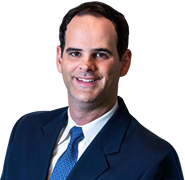Conditions
Spine Deformities
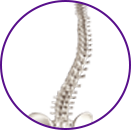
The Spine or backbone provides stability to the upper part of our body. It helps to hold the body upright. It consists of series of irregularly shaped bones appearing in a straight line. The spine has two gentle curves, when looked from the side and appears to be straight when viewed from the front. When these curves are exaggerated, pronounced problems can occur such as back pain, breathing difficulties, and fatigue. Larger curves cause discomfort while the small curves do not cause any problems.
Degenerative Disc Disease
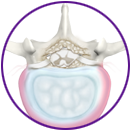
Degenerative Disc Disease is a condition caused by wear and tear on the discs between the vertebrae causing them to lose their cushioning ability. This is a condition where the intervertebral disc, the gel-like material between the vertebrae, has begun to wear out due to aging, repetitive stress, smoking, genetics, etc. In most circumstances the cause is multi-factorial, and unless there is compression of the nerves or spinal cord, will not improve with surgery
Herniated disc (Lumbar)
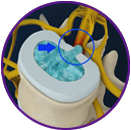
Herniated disc is a condition in which the outer fibers (annulus) of the intervertebral disc are damaged causing the soft inner material of the nucleus pulposus to rupture out of its space. A herniated disc, common in the lower back (lumbar spine) occurs when there is a tear in the outer lining of the disc (annulus fibrosus).This causes the inner jelly-like material (nucleus pulposus) to leak out and place pressure on the adjacent spinal nerve root.
Herniated disc (Cervical)
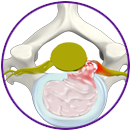
Herniation of a disc is an anomalous spine condition characterized by leakage of the inner contents of the intervertebral disc, due to cracks in its outer wall. Herniated disc is commonly seen in the cervical or neck region, a condition called cervical herniated disc (CHD). CHD is followed by arm or neck pain that may arise due to compression of the spinal nerves by the protruding disc material. This condition is frequently reported in people between 30-40 years of age as well as elderly people.
Cervical Stenosis
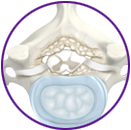
Cervical spine refers to neck portion of spine, and cervical spine conditions may result from overuse injuries, trauma and certain diseases. Cervical stenosis refers to narrowing of the spinal canal that protects the spinal cord and its branching nerves. The condition causes neck pain radiating to arms and hands, numbness or weakness in the legs.
Lumbar Stenosis
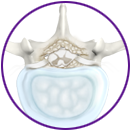
Lumbar stenosis is the compression of spinal nerves caused by narrowing of spinal canal and it is one of the common causes of low back pain. Spinal stenosis can also affect the spine in neck region. The symptoms include back pain, burning or aching type of pain in buttocks that radiates to the legs (sciatica), weakness in the legs or “foot drop”. One of the causes for spinal stenosis is the ageing and other causes include Paget’s disease, achondroplasia, spinal tumors and spinal injuries.
Cervical Disc Protrusion
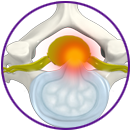
Cervical disc protrusion, commonly known as disc bulge occurs when the spinal discs and associated ligaments are intact, but may form a bulge that will press on the spinal nerves. This condition causes pain in the neck, shoulder and the arms. Usually, the symptoms include a dull, aching, or sharp pain in the neck or the shoulder blades.
Sciatica
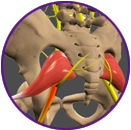
Sciatica is a painful condition caused by the irritation of the sciatic nerve. The sciatic nerve is the longest nerve in our bodies. It begins in the lower back and extends through the buttocks down the back of each leg to the thighs and feet. Sciatica can be acute (short term) lasting a few weeks or chronic (long term) persisting for more than 3 months.
Scoliosis
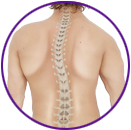
Scoliosis is a condition characterized by abnormal curvature of the spine causing a deviation to one side. It causes a physical deformity making the spine look like the letter “C” or “S” instead of the letter “I”. Scoliosis can affect either the mid or the lower back, but the scoliosis of the mid back is more common. Scoliosis can occur at any age.
Spine Tumors
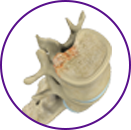
Spine tumor is the abnormal growths of uncontrolled tissues or cells in and around the spinal cord. Tumors can either be cancerous (malignant) or non-cancerous (benign). Some of the commonly occurring benign spinal tumors are osteoma, osteoblastoma, hemangioma, and osteochondroma. Most commonly occurring malignant spinal tumors are chondrosarcoma, Ewing’s sarcoma, lymphoma, osteosarcoma, and multiple myeloma.
Spondylolisthesis
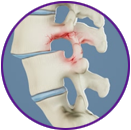
Spondylolisthesis is the displacement of vertebral disc from the spinal column. Outward (forward) displacement is termed as anterolisthesis and inward (backward) displacement is termed as retrolisthesis. This condition is often preceded by spondylolysis, a degenerative condition of the vertebra. Treatment for spondylolisthesis is based on the diagnosis made by collecting medical & family history, physical examination, and radiographic scans.
Ankylosing Spondylitis
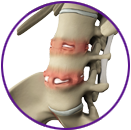
The term ankylosis stands for loss of mobility of the spine, whereas spondylitis means inflammation of the spine. Therefore, ankylosing spondylitis is a condition where chronic inflammation of spine and sacroiliac joint, results in complete fusion of the vertebrae leading to pain and stiffness in the spine. Sacroiliac joints are present in the lower back where the sacrum part of the vertebrae joins the iliac bones.
Adult Kyphosis
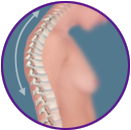
Kyphosis is a condition of abnormal curvature of the spine that causes rounding of the upper back or a hunchback. The thoracic portion of the spine normally has a “C”-shaped curve, but excessive forward curve in the spine leads to kyphosis. In adults, kyphosis may develop as a result of degenerative diseases such as arthritis, disc degeneration, osteoporotic fractures, traumatic injuries and slippage of vertebral disc.
Adult Kyphosis-Types and Causes
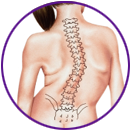
Postural kyphosis is the result of poor posture and is common in adolescents and younger adults. Slouching posture when sitting or standing tends to cause the spine to curve forward. It is often associated with hyperlordosis of the lumbar portion of the spine. The lumbar spine normally has an inward curve.
Scheuermann’s Kyphosis
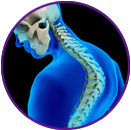
Scheuermann’s kyphosis is a deformity of the spine that develops during growth. It can be considered as increased kyphosis. Kyphosis is the C-shaped curving of the spine and is also known as hunchback. This deformity occurs in the junction between thoracic region and lumbar sections of the spine or in the chest region.
Back Pain

Back pain or backache is the pain felt in the back that may originate from muscles, nerves, bones, joints or other structures in the spine. Back pain is one of the most common medical problems experienced by most people at some time in their life. Back pain can be acute, usually lasting from a few days to a few weeks or chronic, lasting for more than three months.
Neck pain
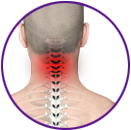
The first 7 vertebral bones on the spinal column form the cervical spine and are located in the neck region. The neck bears the weight of the head, allows significant amount of movement, and is also less protected than other parts of the spine. All these factors make the neck more susceptible to injury or other painful disorders.
Mid-back Pain
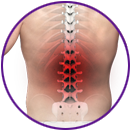
Mid-back pain is also called as thoracic pain or upper back pain. It occurs at the back of the chest and is much less common than lower back pain. It may occur due to poor posture, muscle strain, improper lifting and bending, physical inactivity, sports injury, trauma in a car accident, cancer or an autoimmune disease.
Sacroiliac joint dysfunction
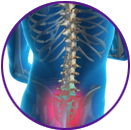
The sacroiliac joint is one of the large joints in the body and is formed by the connection of the sacrum and the right and left iliac (pelvic) bones. The sacroiliac joints have small amount of movement and transmits all the forces of the upper body to the lower body. The sacrum is the triangular-shaped bone at the bottom of the spine, below the lumbar spine. The sacroiliac joint acts as a shock-absorbing structure.
Spine trauma
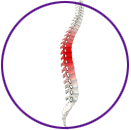
Spine trauma is damage to the spine caused from a sudden traumatic injury caused by an accidental fall or any other physical injury. Spinal injuries may occur while playing, performing normal activities, operating heavy machines, lifting heavy objects, driving automobiles, or when you suffer a fall. Injury to the spine may cause various conditions including fractures, dislocation, partial misalignment (subluxation), disc compression (herniated disc), hematoma (accumulation of blood) and partial or complete tears of ligaments.
Spinal Injuries at work
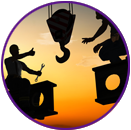
Injuries at work place are very common and may be debilitating. Global statistics report that around 260 million non-fatal injuries occur every year around the world of which 350,000 cases may suffer death. Workplace injuries often occur because of high-risk jobs, lack of or scarcity in safety devices, lack of training and higher numbers of manual workers.
Spinal fractures
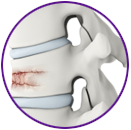
Vertebral compression fractures occur when the normal vertebral body of the spine is squeezed or compressed. The bone collapses when too much pressure is placed on the vertebrae, resulting in pain, limited mobility, loss of height, and spinal deformities. In severe compression fractures the vertebral body is pushed into the spinal canal which will apply pressure on the spinal cord and nerves.
Spondyloarthropathies
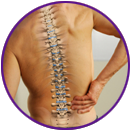
Spondyloarthropathies are a group of chronic inflammatory diseases of the spine and joints. The most common spondyloarthropathies include ankylosing spondylitis, reactive arthritis, psoriatic arthritis and arthritis secondary to inflammatory bowel diseases such as ulcerative colitis and crohn’s disease. Spondyloarthropathies can occur at any age; however, they occur more often in young males.
Spondylolysis
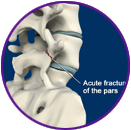
Spondylolysis is a stress fracture of vertebra that may progress into spondylolisthesis, a condition of displacement of vertebrae from the spinal column. Spondylolysis is the cause for frequent low back pain in children. It is more common among children and teenagers who participate actively in sports such as football, weightlifting and gymnastics.
Facet joint arthritis
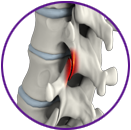
Facet joints, also called zygapophyseal joints, are located at the back of the spine which connects the vertebrae together. There are two joints between each pair of vertebrae located on either side of the spine. The facet joints provide stability for the spine. Facet joint arthritis also known as facet joint syndrome is a form of arthritis that affects the facet joints of the spine.
Piriformis Syndrome
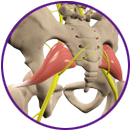
Piriformis Syndrome is an uncommon, rare neuromuscular condition caused by the compression of the sciatic nerve by the piriformis muscle. The sciatic nerve is a thick and long nerve that passes below or through the piriformis muscle and goes down the back of the leg and finally ends in the feet in the form of smaller nerves.
Whiplash
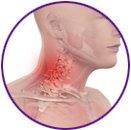
Whiplash is a soft tissue injury to the neck, usually caused by sudden forceful jerk commonly occurring as a result of an automobile accident, sports injuries, or an accidental fall. Sometimes whiplash may also be referred to as neck strain, neck sprain or hyperextension injury.
DISH (Diffuse Idiopathic Skeletal Hyperostosis)

Diffuse idiopathic skeletal hyperostosis (DISH) is a condition commonly affecting the spine characterized by calcification (bony hardening) of ligaments, tendons and joint capsule insertions. Usually the upper portion of the back (thoracic spine) is affected, but it may also involve the neck (cervical spine) and lower back (lumbar spine).
Burners and Stingers
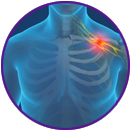
Burners and stingers are common neck or shoulder injuries characterized by intense burning or stinging pain which can radiate from the neck to the hand. They are caused by sudden movement or a direct blow to the neck resulting in an injury to the brachial plexus. This injury is commonly seen in contact sports such as football, ice hockey, wrestling and rugby.
Myelopathy
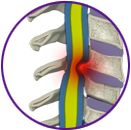
Myelopathy is a term used to refer to diseases that affect the spinal canal. Some of the common myelopathy diseases include carcinomatous myelopathy (degeneration of spinal cord associated with cancer), compressive myelopathy (changes in the spine because of pressure from hematomas or masses) and radiation myelopathy (spine destruction because of X-ray therapy).
Degenerative Spine
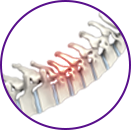
Degenerative spinal conditions are a group of disorders that causes loss of normal structure and function of the spine. These disorders may be caused due to ageing, infection, tumors, muscle strains or arthritis. Degenerative joint disease is commonly known as arthritis that affects feet, fingers, hands, spine and weight-bearing joints. It is caused due to the inflammation of joints because the articular cartilage covering the bones may be damaged or worn out.
Cervical Degenerative Disorders
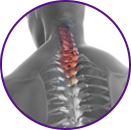
Cervical refers to the 7 vertebrae of the neck. The cervical spine consists of other anatomic structures including muscles, bones, ligaments and joints. Normally, the cervical spine permits quite a range of flexibility and motion. However it is susceptible to physical forces during traumatic injuries. This high range of motion encourages changes associated with spinal wear and tear or age.
Vertebral Fractures
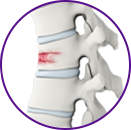
Back pain is an indication of stress fractures known as vertebral compression fractures. Vertebral compression fractures occur when the normal vertebral body of the spine is squeezed or compressed to a smaller height. The bone collapses when too much pressure is placed on the vertebrae, resulting in pain, limited mobility, height loss, and spinal deformity.




 Menu
Menu